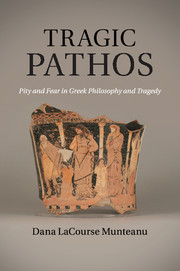Book contents
- Frontmatter
- Contents
- Preface and acknowledgments
- List of abbreviations
- Introduction
- Part i Theoretical views about pity and fear as aesthetic emotions
- Part ii Pity and fear within tragedies
- Chapter 5 An introduction
- Chapter 6 Aeschylus: Persians
- Chapter 7 Prometheus Bound
- Chapter 8 Sophocles: Ajax
- Chapter 9 Euripides: Orestes
- Appendix Catharsis and the emotions in the definition of tragedy in the Poetics
- Bibliography
- Index
Chapter 6 - Aeschylus: Persians
Published online by Cambridge University Press: 05 December 2011
- Frontmatter
- Contents
- Preface and acknowledgments
- List of abbreviations
- Introduction
- Part i Theoretical views about pity and fear as aesthetic emotions
- Part ii Pity and fear within tragedies
- Chapter 5 An introduction
- Chapter 6 Aeschylus: Persians
- Chapter 7 Prometheus Bound
- Chapter 8 Sophocles: Ajax
- Chapter 9 Euripides: Orestes
- Appendix Catharsis and the emotions in the definition of tragedy in the Poetics
- Bibliography
- Index
Summary
A review of interpretations
Any appraisal of the initial reception of Aeschylus’ Persians raises an unusual problem. The play, produced in 472 bce, deals with the Persian defeat at Salamis in 480 bce, only a few years after the event. Could the Athenian spectators have watched a tragedy depicting the fall of their historical enemy with aesthetic detachment? My analysis examines pity and fear as emotions expressed in the tragedy and as possible reactions of the audiences, considering the internal structure, as well as the dramatic and historical milieu of the play. The dramatic background of this tragedy will be compared with other descriptions of the Persian Wars in the art and literature of the time, which probably shaped certain expectations for Aeschylus’ treatment of the topic. Particular emphasis is placed on the ways in which historical circumstances may have conditioned the audience's responses to the emotional appeals of this tragedy.
Modern critics have debated whether Athenian audiences were moved to pity by the ruin of Xerxes in the Persians after seeing the actual destruction caused by the king in Athens. According to some, no dramatic element of the play, not even the final threnody, was designed to lead the spectators toward feeling pity. Others, on the contrary, believe that the Persians should be regarded as a “typical” tragedy, which rises above ethnic differences and historical facts. Consequently, the play would have aroused pity on account of its tragic content, which the spectators saw as an abstract depiction of a human fall rather than in connection with recent history. Both views seem to be extreme. The former eliminates pity, the emotion of tragedy par excellence, as a possible response to the Persians, while the latter emphasizes the emotional effect of the play without considering the complex historical circumstances.
- Type
- Chapter
- Information
- Tragic PathosPity and Fear in Greek Philosophy and Tragedy, pp. 151 - 163Publisher: Cambridge University PressPrint publication year: 2011

